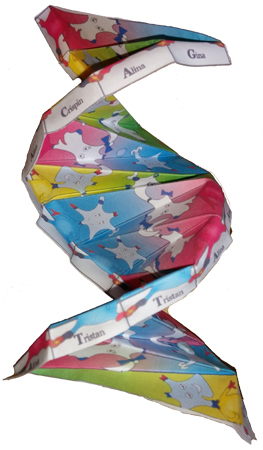There’s been a lot of talk about what humans can do with us and to us, but what can the Dinky Amigos do for humans?
Maybe we should start at the beginning – with the genome. A rather unloved word, I feel. You may hear: “It’s in my DNA” or “It’s in his genes” but very few people blame the genome. So what is it?
It is a collection. A collection of nucleotide bases. If you know all about them, you can stop reading here and do something else. Or you can dissect what I have to say and get back to me in the vain of a fictional physicist in a rather popular US sitcom. Your choice, naturally.
Or is it your choice? What you do now will depend on a number of factors and one of them may be your collection of nucleotide bases. If you are a human (and I’d be mightily impressed if you weren’t and were still reading this. Let me know and I’ll get you on telly) then your collection of these bases expands to just over 3 billion. That’s a lot of dusting – or it would be if they were big enough. Each base is so small you can only see it by firing something like X rays at it. Just as well really, as y ou have trillions of these collections in your body. This collection is known as the Genome – and if you are human, it will be referred to as the Human Genome.
ou have trillions of these collections in your body. This collection is known as the Genome – and if you are human, it will be referred to as the Human Genome.
So, what does a nucleotide base look like? Well, there are four different types in the Genome. They all contain a five-sided (pentameric) chemical known as a ribose sugar. This is attached to a larger chemical containing nitrogen. There are two versions of the larger chemical. One of these is a six-sided (hexameric) ring. Nucleotide bases with these rings are called pyrimidines. The other type of chemical is a six-sided ring attached to a five-sided ring. Nucleotide bases with this arrangement are called purines.
The bases line up next to each other. They are a friendly bunch and all link to each other using part of the ribose sugar (known as a phosphate group). The links are known as a sugar-phosphate backbone. Due to the chemicals that make them, they cannot link up and stay in a straight line, so the row tends to bend – first one way, and then the other, a bit like a spiral or a helix. This helix contains all 3 billion bases in the Human Genome collection.

Bases are maybe sometimes a little too friendly and if left in a single helix, they would also find other chemicals to link up with and ruin the line. So a second helix of bases lines up in the opposite direction to the first one. There is now a double helix and the bases have each got a friend to play with. The friends are very important and a purine base will always partner with a pyrimidine base. Alina (scientifically called Adenine) is a purine base and is attracted only to Tristan (scientifically called Thymine). Gina (scientifically called Guanine) and Crispin (scientifically called Cytosine) will also only partner with one another. Their attraction is stronger too.
The genome is divided up into a number of compartments which we will explore next time.

